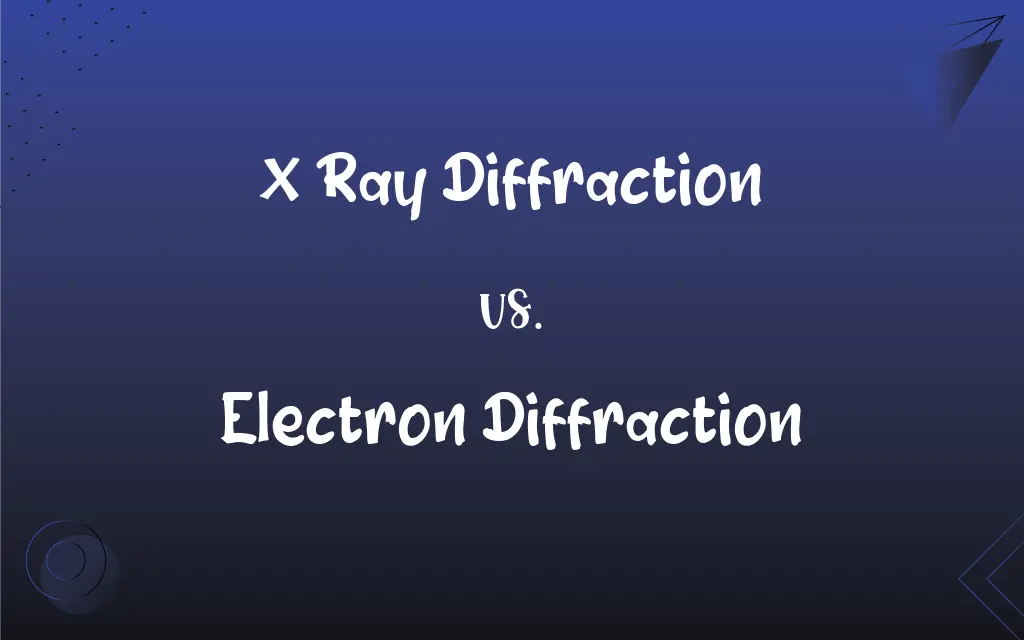X Ray Diffraction vs. Electron Diffraction: What's the Difference?
Edited by Aimie Carlson || By Harlon Moss || Published on February 9, 2024
X-ray diffraction uses X-rays to study crystal structures, while electron diffraction uses electrons for similar purposes but with different resolutions and material interactions.

Key Differences
X-ray diffraction involves the use of X-rays, electromagnetic waves with high energy, to analyze the atomic structure of crystals. Electron diffraction, conversely, employs electrons, which are subatomic particles, to probe the crystal structure. Both techniques are fundamental in materials science for understanding the atomic arrangement in materials.
In X-ray diffraction, X-rays interact with the electron cloud of atoms, causing diffraction patterns that reveal the crystal structure. Electron diffraction, due to the particle nature of electrons, interacts differently with matter, offering more detailed information about the surface structure and thickness of materials. Both methods provide valuable insights into the atomic scale of materials.
X-ray diffraction typically has a higher penetration depth, suitable for bulk material analysis. Electron diffraction, with shorter wavelengths, offers higher resolution but lower penetration depth, making it ideal for thin films and surface studies. Both techniques complement each other in materials characterization.
X-ray diffraction is widely used in identifying and characterizing crystalline materials, phase identification, and determining crystal structures. Electron diffraction is particularly useful in studying surface phenomena, thin films, and nanoscale materials. Both techniques have diverse applications across physics, chemistry, materials science, and biology.
X-ray diffraction requires minimal sample preparation and can analyze larger samples. Electron diffraction, typically performed in an electron microscope, requires more complex sample preparation, often needing thin samples. Both methods require specialized instruments and careful experimental setup.
ADVERTISEMENT
Comparison Chart
Radiation Used
X-rays
Electrons
Interaction with Matter
With electron clouds of atoms
With atomic nuclei and electron clouds
Resolution
Lower resolution, suitable for bulk analysis
Higher resolution, ideal for surface analysis
Penetration Depth
Deeper penetration into materials
Shallower, suited for thin films
Typical Applications
Crystal structure analysis, phase studies
Surface structure, nanomaterials analysis
ADVERTISEMENT
X Ray Diffraction and Electron Diffraction Definitions
X Ray Diffraction
X-ray diffraction is used for analyzing crystal structures.
X-ray diffraction revealed the unknown mineral's crystal lattice.
Electron Diffraction
Electron diffraction examines surface structures.
We studied the surface topology of the thin film using electron diffraction.
X Ray Diffraction
X-ray diffraction characterizes materials' atomic arrangement.
We used X-ray diffraction to confirm the purity of the synthesized compound.
Electron Diffraction
Electron diffraction offers high-resolution imaging.
The electron diffraction technique allowed us to observe fine structural details.
X Ray Diffraction
X-ray diffraction helps in phase identification in solids.
Identifying phases in alloys is simplified with X-ray diffraction.
Electron Diffraction
Electron diffraction exploits the particle nature of electrons.
Electron diffraction helped us understand the electronic properties of the sample.
X Ray Diffraction
X-ray diffraction is a non-destructive testing method.
We checked the integrity of the archaeological artifact using X-ray diffraction.
Electron Diffraction
Electron diffraction analyzes materials at the nanoscale.
Electron diffraction provided insights into the nanostructured material.
X Ray Diffraction
X-ray diffraction has applications in numerous fields.
X-ray diffraction is pivotal in both material science and biology.
Electron Diffraction
Electron diffraction is ideal for thin film analysis.
We assessed the crystallographic orientation of the thin film through electron diffraction.
FAQs
What is X-ray diffraction?
A technique to study crystal structures using X-rays.
How do X-rays interact in X-ray diffraction?
They diffract off the electron clouds in crystals.
What is electron diffraction?
A method to analyze material structures using electrons.
Is electron diffraction limited in sample size?
Yes, often used for thin films or surface layers.
What particles are used in electron diffraction?
Electrons are used to probe material structures.
Can X-ray diffraction analyze large samples?
Yes, it's suitable for larger, bulk materials.
Is X-ray diffraction non-destructive?
Yes, it doesn't alter the sample.
What information does X-ray diffraction provide?
It reveals crystal structure and phase composition.
What details can electron diffraction reveal?
Surface structure, thin film characteristics, and nanomaterials.
Where is electron diffraction commonly used?
In nanotechnology, materials research, and surface science.
Are there any safety concerns with X-ray diffraction?
Yes, proper shielding and safety protocols are needed.
Do both techniques require specialized equipment?
Yes, specific instruments are needed for each.
What industries use X-ray diffraction?
Materials science, geology, biology, and chemistry.
Is electron diffraction good for studying crystals?
Yes, particularly for detailed surface or nanoscale study.
What sample preparation is needed for electron diffraction?
Samples often need to be thin and sometimes conductive.
Can X-ray diffraction identify unknown materials?
Yes, it's a primary tool for material identification.
What's the resolution difference between the two?
Electron diffraction generally provides higher resolution.
Can both techniques be used on the same material?
Yes, they can complement each other in material analysis.
Does electron diffraction require thin samples?
Typically, especially for high-resolution analysis.
How are the samples prepared for X-ray diffraction?
Minimal preparation is needed for most samples.
About Author
Written by
Harlon MossHarlon is a seasoned quality moderator and accomplished content writer for Difference Wiki. An alumnus of the prestigious University of California, he earned his degree in Computer Science. Leveraging his academic background, Harlon brings a meticulous and informed perspective to his work, ensuring content accuracy and excellence.
Edited by
Aimie CarlsonAimie Carlson, holding a master's degree in English literature, is a fervent English language enthusiast. She lends her writing talents to Difference Wiki, a prominent website that specializes in comparisons, offering readers insightful analyses that both captivate and inform.































































